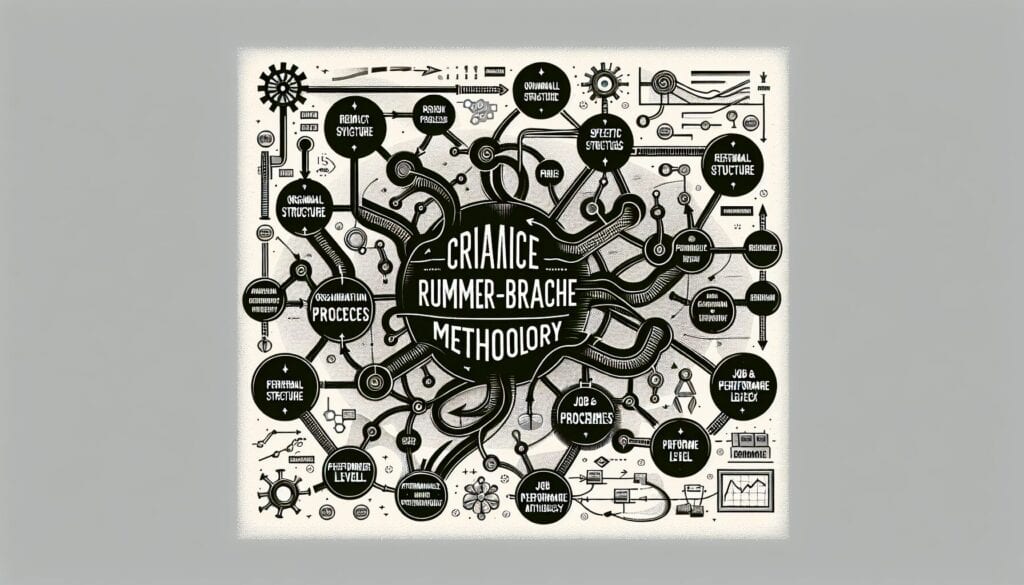Méthodologie d'amélioration des performances qui consiste à considérer une organisation comme un système adaptatif et à gérer les performances à trois niveaux : organisationnel, processus et travail/performances.
- Méthodologies : Clients et marketing, Économie, Conception de Produits
Méthodologie Rummler-Brache

Méthodologie Rummler-Brache
- Méthodologie Agile, Business Process Reengineering (BPR), Gestion du changement, Amélioration continue, Production allégée, Transformation organisationnelle, Suivi des performances, Cartographie des processus, Gestion de la qualité
Objectif :
Comment il est utilisé :
- Met l'accent sur la compréhension de l'"espace blanc" entre les silos fonctionnels où les processus s'effondrent souvent. Utilise des outils tels que la cartographie des processus et l'analyse du système de performance humaine pour diagnostiquer et améliorer les performances.
Avantages
- Fournit un cadre global pour l'amélioration des performances ; relie la stratégie, les processus et les performances individuelles ; aide à identifier et à traiter les problèmes systémiques.
Inconvénients
- Peut être complexe à mettre en œuvre ; nécessite une approche systémique dans l'ensemble de l'organisation ; peut nécessiter une formation importante et un changement culturel.
Catégories :
- Ressources humaines, Gestion de projet, Qualité
Idéal pour :
- Améliorer les performances de l'organisation en analysant et en alignant systématiquement les objectifs, les processus et les performances professionnelles individuelles dans l'ensemble de l'organisation.
La méthodologie Rummler-Brache est particulièrement efficace dans des secteurs tels que les soins de santé, la fabrication, la finance et la technologie, où l'efficacité des processus est essentielle à la réussite de l'organisation. Au cours des phases de planification et d'exécution des projets, cette méthodologie peut être mise en œuvre par des cadres ou des responsables opérationnels désireux d'améliorer l'alignement entre les objectifs stratégiques et les opérations quotidiennes. Les participants sont généralement des équipes interfonctionnelles composées de parties prenantes issues de différents secteurs de l'organisation, car cette méthode favorise la collaboration et la communication entre les différents services. Les outils utilisés dans cette méthodologie, tels que la cartographie des processus, permettent une représentation visuelle des flux de travail, ce qui facilite l'identification des goulets d'étranglement et des domaines à améliorer. L'analyse du système de performance humaine aide à diagnostiquer les problèmes en examinant l'impact des comportements individuels sur la performance globale. Cette approche systématique permet non seulement de cibler les problèmes existants, mais aussi de s'assurer que les initiatives futures sont alignées sur les objectifs à long terme de l'organisation. Le cadre soutient les efforts d'amélioration continue, en favorisant une culture où le retour d'information est intégré dans les examens des performances et les évaluations de projets, encourageant ainsi les stratégies adaptatives qui peuvent être mises en œuvre en temps réel. Ainsi, les organisations qui emploient cette méthodologie font souvent état d'un engagement et d'une responsabilisation accrus des employés, car ceux-ci comprennent que leurs performances influencent directement le succès de l'organisation.
Principales étapes de cette méthodologie
- Identifier les buts et objectifs de l'organisation.
- Cartographier les processus actuels à travers les silos fonctionnels.
- Analyser l'"espace blanc" entre les processus pour déceler les ruptures de performance.
- Évaluer les performances professionnelles individuelles liées aux processus.
- Identifier les problèmes systémiques affectant les performances de l'organisation.
- Élaborer des interventions ciblant les problèmes identifiés.
- Mettre en œuvre des améliorations de processus et des initiatives de formation.
- Contrôler l'évolution des performances et procéder aux ajustements nécessaires.
Conseils de pro
- Mener régulièrement des examens interfonctionnels pour mettre en évidence les inefficacités cachées et aligner les objectifs entre les silos.
- Utiliser l'analyse des données pour identifier les écarts de performance et quantifier l'impact des changements de processus sur les résultats.
- Développer une culture du retour d'information permanent et de la communication ouverte afin d'atténuer la résistance au changement et d'améliorer la collaboration.
Lire et comparer plusieurs méthodologies, nous recommandons le
> Référentiel méthodologique étendu <
ainsi que plus de 400 autres méthodologies.
Vos commentaires sur cette méthodologie ou des informations supplémentaires sont les bienvenus sur le site web de la Commission européenne. section des commentaires ci-dessous ↓ , ainsi que toute idée ou lien en rapport avec l'ingénierie.
Contexte historique
1962
1970
1972
1980
1980
1986
1986
1960
1963
1970
1980
1980
1980
1986
1987
(si la date est inconnue ou n'est pas pertinente, par exemple "mécanique des fluides", une estimation arrondie de son émergence notable est fournie)















Articles Similaires
Gestion des opérations de fabrication (MOM)
Système d'exécution de la fabrication (MES)
Plan de contrôle de la fabrication
Tests manuels
Tableaux d'évaluation des manutentions manuelles (MAC)
ManTRA (outil d'évaluation des risques liés aux tâches manuelles)